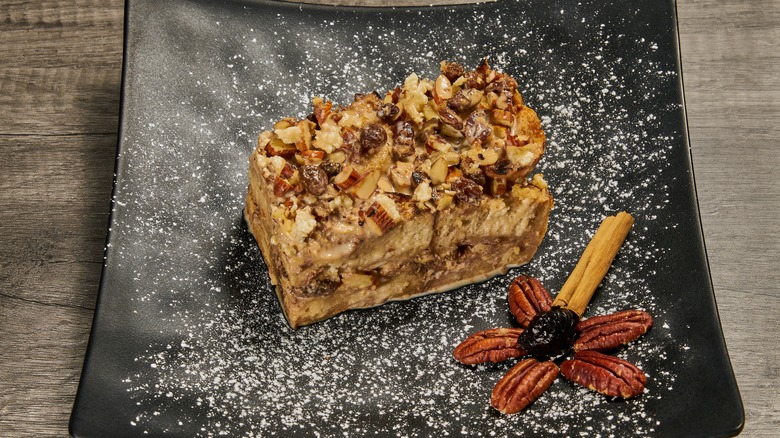Capirotada Is A Classic Mexican Dessert With 2 Unique Savory Twists - Exclusive
When we think of spring we think of flowers peeking out from the thawed earth, store shelves lined with jelly beans and gooey Cadbury eggs, and all those amazing spring desserts. While our favorites are strawberry shortcake or a tangy lemon meringue pie, culinary anthropologist and chef Claudette Zepeda's first choice is always capirotada.
Capirotada is often mistaken for bread pudding, but Zepeda informed us in an exclusive interview that since there aren't any eggs in the recipe, it really doesn't qualify as a bread pudding. Instead, the Mexican dessert is made with deep-fried day-old bread that is layered with peanuts, coconut, and raisins, and then drenched in a sweet syrupy sauce.
While most syrups are made of sugar, maple, or molasses, the syrup for capirotada is a combination of piloncillo (a type of unrefined cane sugar), tomatoes, and onions. We know that sounds like an odd mix, but Zepeda swears it works. "It is the most decadent. You would think it would be super sweet but because of the onions and tomatoes, it gives it the most unreal balanced flavor," the chef explains. "It's weird. There's no way I can make it sexy."
Why Claudette Zepeda prefers the tomato and onion addition
Sweet is not the word that comes to mind when we think of onions and tomatoes, but Zepeda disagrees. A staple in savory dishes from all over the world, the chef says that onions actually have tons of natural sugar in them that comes out when they're cooked. Tomatoes, especially heirloom tomatoes, can also be quite sweet. Because these two veggies can be so sweet, Zepeda insists you would never know they're part of the capirotada recipe. "In a blindfold test, no one can tell you [the syrup] has got onions and tomatoes in it. But their natural sugars make it a very balanced syrup," she explains.
Piloncillo, the other part of the capirotada syrup, is very sweet thanks to the cane juice that's used to make it. Zepeda says it's "intoxicating" thanks to its mineral and molasses flavor. So, when it's combined with the tomatoes and onions you get this rich syrup that, while delicious, Zepeda admits doesn't make any sense. "I wish I could understand the witchcraft behind why it works," the chef says. "I don't question things sometimes. That's one I don't question."
Keep up with the latest from Claudette Zepeda on her website.

